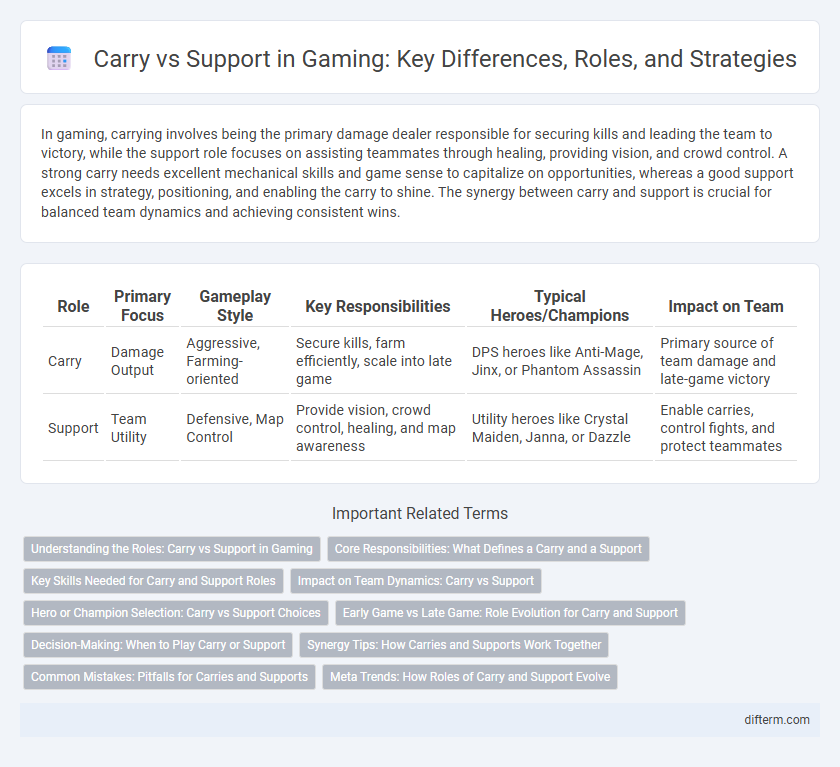In gaming, carrying involves being the primary damage dealer responsible for securing kills and leading the team to victory, while the support role focuses on assisting teammates through healing, providing vision, and crowd control. A strong carry needs excellent mechanical skills and game sense to capitalize on opportunities, whereas a good support excels in strategy, positioning, and enabling the carry to shine. The synergy between carry and support is crucial for balanced team dynamics and achieving consistent wins.
Table of Comparison
| Role | Primary Focus | Gameplay Style | Key Responsibilities | Typical Heroes/Champions | Impact on Team |
|---|---|---|---|---|---|
| Carry | Damage Output | Aggressive, Farming-oriented | Secure kills, farm efficiently, scale into late game | DPS heroes like Anti-Mage, Jinx, or Phantom Assassin | Primary source of team damage and late-game victory |
| Support | Team Utility | Defensive, Map Control | Provide vision, crowd control, healing, and map awareness | Utility heroes like Crystal Maiden, Janna, or Dazzle | Enable carries, control fights, and protect teammates |
Understanding the Roles: Carry vs Support in Gaming
The carry role in gaming primarily focuses on dealing high damage and scaling into the late game to secure victories, often requiring significant farm and experience. Support players prioritize vision control, crowd control, and protecting teammates by providing heals, buffs, or disables to enable the carry's success. Effective teamwork and role synergy between carry and support often determine the outcome of competitive matches.
Core Responsibilities: What Defines a Carry and a Support
In gaming, a carry is primarily responsible for dealing the majority of damage and securing kills to lead the team to victory, often requiring strong farming and positioning skills. A support's core responsibility is to assist the carry and the team through vision control, healing, crowd control, and providing utility that enhances overall team survivability. Effective coordination between carry and support roles ensures strategic resource allocation and maximizes team performance in competitive matches.
Key Skills Needed for Carry and Support Roles
Carry roles demand high mechanical skill, strong positioning, and the ability to farm efficiently under pressure to maximize late-game impact. Supports require excellent map awareness, vision control, and effective crowd control or healing abilities to protect and enable carries. Communication and game sense are crucial for both roles to coordinate team strategies and execute timely plays.
Impact on Team Dynamics: Carry vs Support
Carry players drive team success by securing kills and dealing high damage, directly influencing the outcome of team fights and overall match momentum. Support players enhance team dynamics by providing vision control, crowd control, and saving teammates, enabling carries to maximize their potential safely. The synergy between carry and support roles fosters balanced team performance, where strategic positioning and resource management determine victory.
Hero or Champion Selection: Carry vs Support Choices
Choosing the right hero or champion in gaming directly impacts team dynamics, with carry roles typically selecting high-damage, late-game scaling characters who require protection and farm priority. Support choices prioritize utility, crowd control, and vision to enable the carry's success while sustaining team fights and map control. Effective hero selection balances these roles to maximize synergy, ensuring the carry thrives while the support facilitates objectives and team survivability.
Early Game vs Late Game: Role Evolution for Carry and Support
Carry champions excel in the late game due to their high damage output and scaling abilities, often relying on accumulated farm and experience from the early game to become the team's primary damage dealers. Support roles focus on controlling vision, providing utility, and enabling carries during the early game, often sacrificing personal resources to ensure the carry's growth. As the game progresses, supports shift from a protective role to facilitating team fights and objective control, while carries transition from farming to dealing decisive damage.
Decision-Making: When to Play Carry or Support
Choosing between carry and support roles depends on individual playstyle and team composition, as carries focus on maximizing damage output while supports prioritize vision control and utility. Decision-making requires assessing early game momentum, resource availability, and the enemy lineup to determine when to transition from farming to team fighting or map control. Optimal role selection balances personal skill strengths with strategic needs to enhance overall team performance in competitive matches.
Synergy Tips: How Carries and Supports Work Together
Carries and supports maximize their impact through precise synergy, where supports provide crowd control, healing, and vision to enable carries to deal consistent damage safely. Effective communication ensures support abilities are timed to protect carries during engagements, while carries position strategically to capitalize on those protections. Understanding each other's cooldowns and playstyles fosters seamless teamwork that dominates objectives and secures victories.
Common Mistakes: Pitfalls for Carries and Supports
Carries often fall into the trap of over-farming and neglecting map awareness, leading to missed opportunities for team fights and objectives. Supports frequently make the mistake of not properly warding key areas or overextending without backup, resulting in crucial vision loss or unnecessary deaths. Both roles must balance aggression and caution to maximize their impact, avoiding tunnel vision on personal performance over team coordination.
Meta Trends: How Roles of Carry and Support Evolve
The evolving meta in gaming highlights the shifting dynamics between carry and support roles, with carries now often integrating utility alongside damage output to adapt to faster-paced and more team-oriented strategies. Support roles increasingly prioritize vision control, crowd control, and team sustain to maximize the carry's impact, reflecting a meta that values synergy and macro play. Data from recent esports tournaments shows that successful teams exhibit flexible role adaptation, where carry and support players interchange responsibilities to exploit strategic advantages.
carry vs support Infographic

 difterm.com
difterm.com